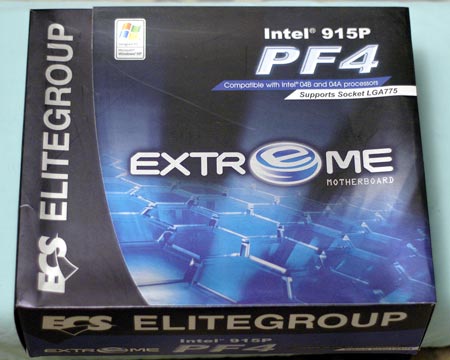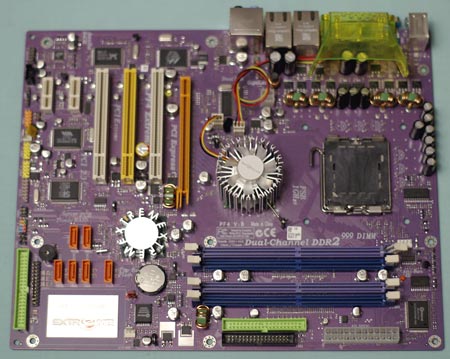915 Motherboard Roundup: Socket 775 for the Rest of Us
by Wesley Fink on December 7, 2004 12:25 AM EST- Posted in
- Motherboards
ECS PF4 915P Extreme: Features and Layout
| ECS PF4 915P Extreme Motherboard Specifications | |
| CPU Interface | Socket 775 Pentium 4 (Prescott) |
| Chipset | Intel 915P/ICH6 |
| BUS Speeds | 200MHz to 510MHz (in 1MHz increments) |
| DDR2 Speeds | Auto, 400, 533 |
| PCI Speeds | Asynch, Synch |
| Core Voltage | Auto, 1.125V to 1.5875V in .015V increments |
| DRAM Voltage | 1.8V to 2.2V in 0.1V increments |
| PCIe Voltage | 1.50V to 1.675V in .025V Increments |
| Memory Slots | Four 240-pin DDR2 Slots Dual-Channel Unbuffered Memory to 4GB |
| Expansion Slots | 1 PCIe x16 Slot 2 PCIe x1 Slots 3 PCI Slots |
| Onboard SATA/RAID | 4 SATA 150 drives by ICH6 Plus 2 SATA 150 by SiS 180 (SiS drives can be combined in RAID) |
| Onboard IDE/RAID | One Standard ATA100/66 (2 drives) Plus 2 Ultra ATA 133/100/66 By SiS 180 (SiS drives can be combined in RAID) |
| Onboard USB 2.0/IEEE-1394 | 8 USB 2.0 ports 2 IEEE 1394a FireWire Ports by VIA VT6307 |
| Dual Onboard LAN | Gigabit PCI Ethernet by Marvell 88E8001 10/100 PCI by Realtek 8100C |
| Onboard Audio | C-Media CMI9880 8-Channel with SPDIF |
| Tested BIOS | 1.1a AMI |
In the last year, ECS has been pushing for greater respect at the top end of the motherboard market with flashier designs and adjustment options associated with top-end boards aimed at the enthusiast. They call these boards their "Extreme Motherboards" and the PF4 915P is part of the new series. What makes the board Extreme? For starters, it is the packaging.

The PF4 915P comes in a foil box with an information flap, more like you would see with a Gigabyte board. Fortunately, ECS opted for a subdued blue, silver and black design that doesn't shout off the shelves. Inside the box is a very Abit-like group of fitted inside boxes for manuals and accessories. A very complete range of accessories is included. Particularly noteworthy are round black cables. Also included is a slot mount or 3-1/2 inch bay mount USB2/Firewire port bracket. This option is very clever and worth copying by other manufacturers. Despite the high-end image and packaging, ECS has priced the PF4 915P to compete with mainstream boards, as it is currently selling in the $120 to $130 price range in web stores.
The board itself is a soft medium purple with color used to locate most-used connectors easily. You can see the rounded corners, huge active Northbridge heatsink, and a Southbridge sink with fins that spell "EXTREME". ECS even includes a rear exhaust fan in the IO area to pull heat from the CPU area of the 4-phase design.

Layout of the PF4 915P is very clean. In addition to the huge standard list of 915P features, ECS adds a SiS 180 controller for 2 additional SATA ports and an added IDE connector. The SiS ports can be combined in RAID - a good thing, since ECS chose to use the ICH6 south bridge without RAID capabilities. Two Firewire ports are also provided for those who want on-board Firewire, and the Azalia high-definition 8-channel audio is driven by a C-Media codec.
Layout is better than average. Thankfully, the IDE and floppy connector are in our preferred right edge location, with the added IDE connector at the bottom edge. The 24-pin ATX power connector is also on the right edge, out of the way in most cases. The 4-pin connector, however, is near the center of the board between the CPU and rear IO ports, requiring the cable to be snaked around the CPU. We prefer a board-edge location, but the cable is actually easier to maneuver, since it has just 4 wires.
ECS makes quite a bit of noise about the Dual LAN capabilities of the PF4. Dual LAN is a nice feature, but in this case, one is Gigabit and one is 10/100. To make matters worse, both LANs are on the PCI bus. This is not an issue with the 10/100, but the Gigabit LAN would have been much more capable on the PCI Express bus.
All-in-all, there is little to complain about the layout or features provided on the ECS. It would have been nice to see an ICH6R instead and a PCIe Gigabit LAN, but these will only be important to some users. The BIOS options are certainly much more generous than what we are accustomed to seeing with ECS designs. ECS appears to have met their design goal of positioning the PF4 915P Extreme as a premium board with a nice mainstream price. If performance and overclocking match the layout and features, ECS will have a potent player in the market.
DFI LANParty UT 915P-T12: Overclocking and Stress Testing
ECS PF4 915P Extreme: Overclocking and Stress Testing










26 Comments
View All Comments
krelian - Wednesday, December 8, 2004 - link
I been a Intel user since the first Pentium 3 came out now I have a Intel P4 3.0C I refused to spend more money on things I had already bought so I stayed with the 478 socket, seeing as Intel wants me to move to an expensive platform, I say I'll ditch Intel head with the AMD crowd, I'm sure I won't be the only one, maybe legions of intel campers will leave.ChineseDemocracyGNR - Tuesday, December 7, 2004 - link
About the config I put together in the previous post; does anyone know if the overclock lock on the 915P chipsets apply to lower FSB's too? Could I overclock the 133MHz Celeron D to 200MHz on any 915P motherboard?ChineseDemocracyGNR - Tuesday, December 7, 2004 - link
The 915P chipset provides good value for the money. For example:ECS 915P-A $79
Intel Celeron D 325J 2.53GHz $88
Albatron GeForce 6600 128MB $120.50
or
Albatron GeForce 6600GT 128MB $190.50
(newegg prices)
The processor can be overclocked to 3.6+GHz very easily, much like the Athlon Mobiles.
That makes a good budget gaming rig, better than anything you could put together with an AMD processor for the same money. So, at least in my opinion, AMD has a better mainstream/high-end processor, and Intel wins the value segment. Who would say?
--
I have now read the entire article, and oh boy! Though I prefer to read about socket 754/939 motherboards, this has to be the best motherboard roundup I ever read. Ever. Well done.
--
#22,
thank your fixing it. The typo I wrote about on page 10:
"The fact that Asus manages a higher OC than more recognized OC boards like DFI and Asus "
Don't you mean ABIT in the last word there?
ocyl - Tuesday, December 7, 2004 - link
Wesley > Thank you for paying attention to the audio features/components of these motherboards, particularly Dolby Digital Live :)Wesley Fink - Tuesday, December 7, 2004 - link
#21 - The Foxconn results have been corrected on p.20. Thank you for bringing it to our attention.ChineseDemocracyGNR - Tuesday, December 7, 2004 - link
A few typos:"The fact that Asus manages a higher OC than more recognized OC boards like DFI and Asus "
page 10.
On page 20, the "Front Side Bus Overclocking Testbed" table is probably wrong.
---
Good article.
LeadFrog - Tuesday, December 7, 2004 - link
Why does only the socket 915 get a 16mb cache Hard Drive?danidentity - Tuesday, December 7, 2004 - link
Wes, I said thanks before but I'll say it again, great roundup. We appreciate your hard work, always.danidentity - Tuesday, December 7, 2004 - link
Live -The P5GD2 is expensive compared to most boards, but it includes a ton of stuff, like 8 SATA ports, dual gigabit LAN, on-board 802.11g/b, and on-board hi-def audio with Dolby Digital Live (realtime encoding, like SoundStorm).
Most 915P boards aren't as close to as expensive as the Asus. The Abit AG8 is ~ $130, equal or cheaper in price than the K8N Neo2.
Wesley Fink - Tuesday, December 7, 2004 - link
#16 - After I did the price analysis today I changed "outstanding value" to "good value". Thanks for the comment about the review being good reading. It is appreciated as a huge amount of work went into this roundup.